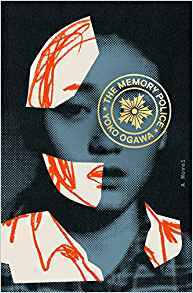
Going into this novel, I expected a political dystopia similar to that of George Orwell’s 1984. Despite sharing the theme of a surveillance state, however, the two stories have very little in common. Unlike 1984, The Memory Police, while undoubtedly being a tale about the pitfalls of totalitarianism, focused much more on the individual, existential aspect of such a situation than the how and why. What makes us who we are? What happens to a person’s spirit when their culture has been eradicated, when they have nothing left to root their identity in? This story concludes with the thought that they will simply fade away. This is the intention of people who destroy cultures: to destroy the people connected to them.
Of course, this isn’t just a story about things being taken from people. They are literally gone from people’s memories. Someone can pick up a piece of ribbon and feel it, see it for what it is, but it is meaningless to them — they have no memory of it, no emotional connection to it. It is as though they have never encountered a ribbon before, and don’t see why they should care to. This is not something that can really happen to people, at least not intentionally or on a large scale. I believe that this is a fantastical condensation of something that happens over a span of generations. In real life, when a culture is “disappeared,” it is not the people who lived in it before that lose their deeper connection to it, but their children and grandchildren, who must be raised in a world where the things that their parents and grandparents held dear no longer exist. They may hear bits and pieces of what once was from their elders, but it will be largely meaningless to them, removed from their personal reality. They will have lost something that they never had. Condensing this generational experience into a single person makes it more poignant, more visible, so that the reader can see just how invasive a loss of culture really is into every aspect of a person’s life.
There are also the people in this story who do not forget. The people who remember, who could hypothetically pass knowledge onto those who do not, must be disappeared, too, in order to prevent that from happening. I believe that the existence of these characters serves multiple purposes. First, I think that they serve to represent people watching their children and grandchildren live divorced from their heritage. Second, they provide contrast to the ones who do not remember. Their relative fullness makes the emptiness of those who have forgotten even more striking. Even then, there may be things that were disappeared before they were born, that nobody has hope of remembering. The last is that they are the only ones who can say certain things that Ogawa felt needed to be said. R, the narrator’s editor who does not forget, tries again and again to encourage her to remember. He pushes her to finish her novel, which never could have happened without his influence, and he espouses the importance and necessity of remembering.
The novel that the narrator writes is clearly of great importance. It runs parallel to the actual novel’s main storyline: the narrator’s life. It explores its main character’s loss of self and of the will to continue. Most importantly, the narrator of the main story manages to finish it despite its disappearance. What does this mean? The implication here is that, although difficult, it is possible to get something back once it has been disappeared. Similarly, the narrator speaks about disappeared things as though she knows they are still inside her somewhere, however unreachable, and with practice she comes closer to reaching them. Still, it is not enough, and she succumbs to the disappearance anyway. In the end, she is left in the secret room with the other disappeared things, and she only asks to be remembered.

 “The Resident” follows an author who has been accepted into an artists’ residency in the mountains where she used to go to girl scout camp. At the beginning, she is elated, but as time passes she becomes increasingly uneasy. For much of this story, and even to an extent still, I was unsure of the exact fantastic element. The most explicitly “fantastic” event, to me, was the appearance on her doorstep of the other half of the rabbit, but even this is not unexplainable. I think that the fantastic element of this story is stored in the way it is written. The writing gives off the impression that the residency contains some vague but malevolent presence, causing the narrator’s unsettling experiences and the progressive loss of her sanity. This was achieved using a variety of horror tropes: The last-stop at the gas station with a strange, unfamiliar program on the tv and a cashier who freezes up at the mention of the narrator’s destination; the expectation that a hand will shoot out from under the bed; the recurring bad weather; the unexplained illnesses; the sudden darkness in the woods; the portrait of the narrator in which she appears utterly dead; the appearance of the rabbit. The narrator herself is aware of the tropes that she is experiencing, and the fact that they are cliché. This ties into my second topic of analysis.
“The Resident” follows an author who has been accepted into an artists’ residency in the mountains where she used to go to girl scout camp. At the beginning, she is elated, but as time passes she becomes increasingly uneasy. For much of this story, and even to an extent still, I was unsure of the exact fantastic element. The most explicitly “fantastic” event, to me, was the appearance on her doorstep of the other half of the rabbit, but even this is not unexplainable. I think that the fantastic element of this story is stored in the way it is written. The writing gives off the impression that the residency contains some vague but malevolent presence, causing the narrator’s unsettling experiences and the progressive loss of her sanity. This was achieved using a variety of horror tropes: The last-stop at the gas station with a strange, unfamiliar program on the tv and a cashier who freezes up at the mention of the narrator’s destination; the expectation that a hand will shoot out from under the bed; the recurring bad weather; the unexplained illnesses; the sudden darkness in the woods; the portrait of the narrator in which she appears utterly dead; the appearance of the rabbit. The narrator herself is aware of the tropes that she is experiencing, and the fact that they are cliché. This ties into my second topic of analysis.  “Eight Bites” was a difficult story to read. The narrator experiences so much pain mentally and emotionally that I found it hard to continue. I think this is due to the fact that even though the point of view is in first person, we can understand the conflicts and struggles of the other characters (Or, rather, the main character understands the conflicts of the other characters and doesn’t want to admit it). For example, the main character is the mother of Cal, her distant daughter who is described as “furious constantly” and “all accusation.” (158) Her daughter is angry at her for wanting the surgery, which she sees as an attack against her own body, and the main character cannot understand why the daughter can’t accept her body as flawed.
“Eight Bites” was a difficult story to read. The narrator experiences so much pain mentally and emotionally that I found it hard to continue. I think this is due to the fact that even though the point of view is in first person, we can understand the conflicts and struggles of the other characters (Or, rather, the main character understands the conflicts of the other characters and doesn’t want to admit it). For example, the main character is the mother of Cal, her distant daughter who is described as “furious constantly” and “all accusation.” (158) Her daughter is angry at her for wanting the surgery, which she sees as an attack against her own body, and the main character cannot understand why the daughter can’t accept her body as flawed.
 In this particular story, we are greeted with elements parallel to that of both European-esque folk and fairy tales. More specifically, the integration of magical dresses into the properties of fanciful and illusory illustrated internally bring to mind the infamous tale of “Cinderella.” This prominence; this focus on the gowns promotes and encourages comparisons to relating stories, stories oftentimes told to young girls. Simultaneously, the concluding dissipation and destruction of the female body draws parallels to “The Little Mermaid.” However, the desolation and sorrow encompassed in this particular story and –oftentimes lacking in children’s fairy tales– encourage a more mature audience, an audience no longer innocent, naive, and sheltered from the obscurities of being a woman in society, who are attempting and ultimately failing to either meet or discourage these set standards. There’s a disintegration, a fading of sorts, as women grow and abandon their youths to discover that the real world is nothing like glass slippers, magical wands, and happy endings.
In this particular story, we are greeted with elements parallel to that of both European-esque folk and fairy tales. More specifically, the integration of magical dresses into the properties of fanciful and illusory illustrated internally bring to mind the infamous tale of “Cinderella.” This prominence; this focus on the gowns promotes and encourages comparisons to relating stories, stories oftentimes told to young girls. Simultaneously, the concluding dissipation and destruction of the female body draws parallels to “The Little Mermaid.” However, the desolation and sorrow encompassed in this particular story and –oftentimes lacking in children’s fairy tales– encourage a more mature audience, an audience no longer innocent, naive, and sheltered from the obscurities of being a woman in society, who are attempting and ultimately failing to either meet or discourage these set standards. There’s a disintegration, a fading of sorts, as women grow and abandon their youths to discover that the real world is nothing like glass slippers, magical wands, and happy endings. Yet the folktale aspect still stands true. The general type of story, where a man or prince meets a woman not entirely whole; not entirely human, and they embark on a romantic association that is sometimes one-sided (as perceived in the selkie stories), are widespread and sprinkled within stories still told today. Always in the end, the woman finds means of escaping and is able to return to her own; return to the sense of womanhood represented by the dresses. These specifically obscure fairytales with darker attributions and themes come to reflect a sense of cultural entrapment. Brides married off too young, women stolen from their homes, etc. This apprehension conveys the ideals of the control that men have, the capacity to capture, to misunderstand, and to rip away at the seams of womanhood until there is nothing left; until they fade away into nonexistence.
Yet the folktale aspect still stands true. The general type of story, where a man or prince meets a woman not entirely whole; not entirely human, and they embark on a romantic association that is sometimes one-sided (as perceived in the selkie stories), are widespread and sprinkled within stories still told today. Always in the end, the woman finds means of escaping and is able to return to her own; return to the sense of womanhood represented by the dresses. These specifically obscure fairytales with darker attributions and themes come to reflect a sense of cultural entrapment. Brides married off too young, women stolen from their homes, etc. This apprehension conveys the ideals of the control that men have, the capacity to capture, to misunderstand, and to rip away at the seams of womanhood until there is nothing left; until they fade away into nonexistence.



 “Thank you. They won the gold medal at last year’s fair, you know.” My comment seemed to have pleased her. “They are the last most beautiful memento I have of my late father.” But there was no regret in her voice as she tore apart the petals and sent them fluttering into the water. The polish on her fingernails was nearly the same shade as the flowers. Once her work was done, she turned and, without a glance at the stream, gave me the sort of graceful bow typical of people of her class and left.
“Thank you. They won the gold medal at last year’s fair, you know.” My comment seemed to have pleased her. “They are the last most beautiful memento I have of my late father.” But there was no regret in her voice as she tore apart the petals and sent them fluttering into the water. The polish on her fingernails was nearly the same shade as the flowers. Once her work was done, she turned and, without a glance at the stream, gave me the sort of graceful bow typical of people of her class and left. no longer a deeper meaning in this subject matter, and it no longer exists to her mind. There is an absence that is perfectly expressed. The feelings of the reader contrast heavily with the feelings of both the woman and the narrator – for we know what is supposed to be there, what is supposed to be felt. There
no longer a deeper meaning in this subject matter, and it no longer exists to her mind. There is an absence that is perfectly expressed. The feelings of the reader contrast heavily with the feelings of both the woman and the narrator – for we know what is supposed to be there, what is supposed to be felt. There 

